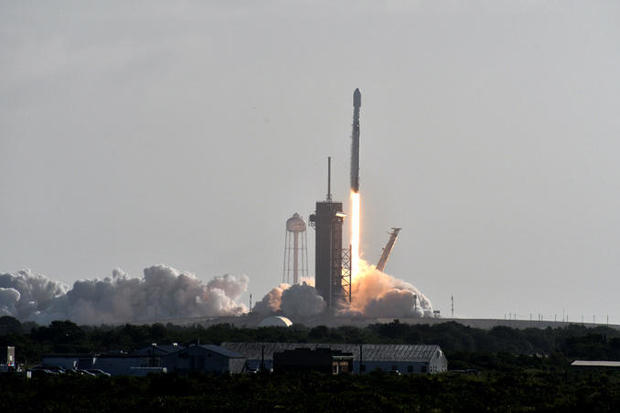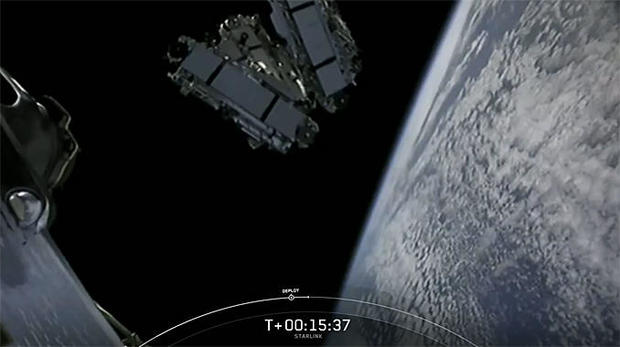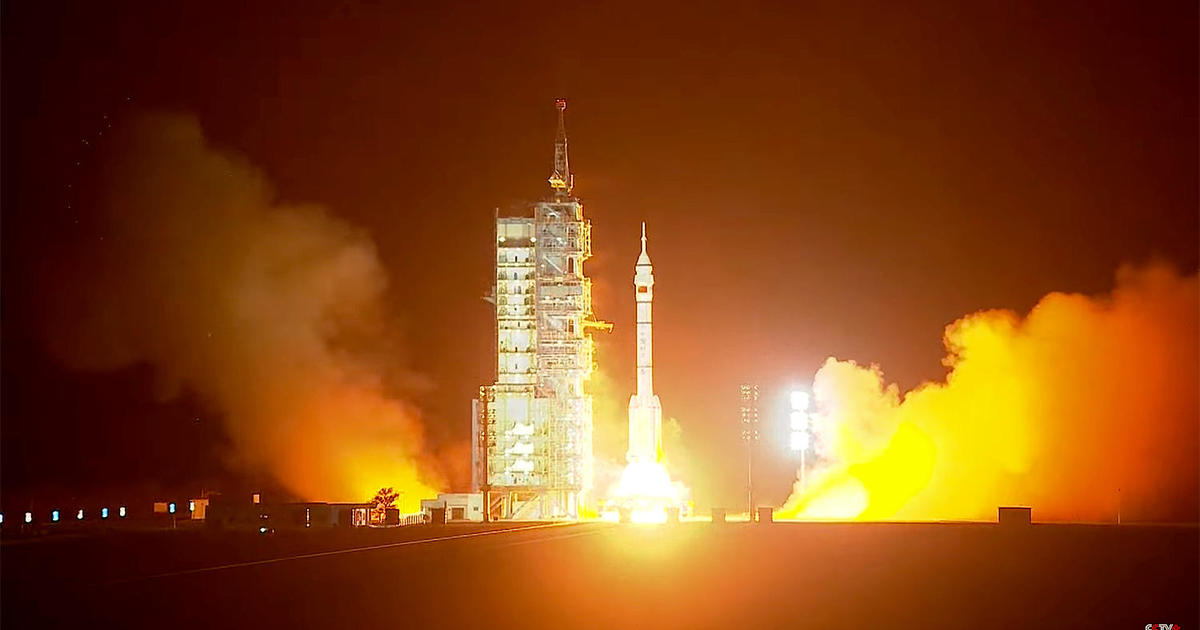SpaceX launches 60 more Starlink satellites in fast-growing constellation
SpaceX launched a Falcon 9 rocket carrying another 60 Starlink satellites into orbit Thursday, boosting the total number launched to date to 713 in a fast-growing constellation of internet relay stations.
Just four days after launching an Argentine remote-sensing satellite from the Cape Canaveral Air Force Station, SpaceX fired off its 12th Starlink mission from pad 39A at the Kennedy Space Center at 8:46 a.m. EDT. It was the company's 93rd launch of a Falcon 9, its 16th so far this year and its 101st overall.
Generating 1.7 million pounds of thrust, the nine Merlin engines powering the previously flown first stage boosted the rocket out of the thick lower atmosphere. The stage then separated and headed for landing on an off-shore droneship, touching down on the "Of Course I Still Love You" about eight minutes and 20 seconds after liftoff.
The landing marked SpaceX's 60th successful booster recovery, its 40th on droneships.
The second stage, meanwhile, completed the climb to orbit about a half minute later and the Starlinks were released in a single batch, slowly spreading apart as they drifted away.
SpaceX has regulatory approval to launch more than 12,000 Starlink satellites that will work together in a global network to provide high-speed internet access anywhere in the world. Amazon plans a similar constellation with its Kuiper project, and OneWeb, in the process of emerging from bankruptcy, plans yet another such network.
Starlink engineers have been testing their growing system before rollout of a public beta program later this year, and "initial results have been good," said SpaceX launch commentator Kate Tice.
"They show super low latency and download speeds greater than 100 megabytes per second," she said. "That means our latency is low enough to play the fastest online video games, and our download speeds are fast enough to stream multiple HD movies at once and still have bandwidth to spare."
The company is testing inter-satellite laser links designed to enable data relay from one Starlink to another, providing seamless service as satellites pass over a user's location.
"With these space lasers, the Starlink satellites are able to transfer hundreds of gigabytes of data," Tice said. "Once these space lasers are fully deployed, Starlink will be one of the fastest options available to transfer data around the world."
The prospect of vast numbers of low-Earth orbit satellites, dubbed LEOsats, has touched off widespread concern among astronomers about the threat posed by reflected sunlight during sensitive observations. While the satellites might not be visible to the unaided eye, many will show up as streaks across time exposures captured by the world's most powerful telescopes.
One study concluded more than 100,000 LEOsats could be launched over the next ten years, 70 percent of them operated by SpaceX, Amazon and OneWeb. The American Astronomical Society and the National Science Foundation's NOIRLab hosted a virtual workshop earlier this summer to discuss the impacts of such constellations.
"With tens of thousands of LEOsats, as planned, we found that generally no combination of mitigations, of all the mitigations we studied, can completely avoid the impacts of LEO satellites on the science programs of the coming generation of optical astronomy facilities," said Tony Tyson, project scientist for the Large Synoptic Survey Telescope at the Vera C. Rubin observatory in Chile.
But astronomers hope to minimize that impact to some extent, working with spacecraft builders to modify their satellite designs and orbits. Keeping satellite constellations below an altitude of about 373 miles, for example, would reduce the number of spacecraft visible high in the sky as seen from ground.
Other options include darkening the satellites to make them less reflective and orienting the spacecraft so they orbit "edge on," reducing the surface area reflecting sunlight to the ground.
At the same time, astronomers must develop software to remove or mask satellite trails in telescope images and develop pointing algorithms to avoid brighter satellites. Both options "may not be feasible for many science programs," said Jeff Hall, an astronomer at the Lowell Observatory in Flagstaff, Arizona.
SpaceX, for its part, is working with the astronomical community to test different methods for reducing the reflectivity of its Starlinks. The company has already implemented tests of so-called "darksats" and added sunshades to reduce reflections.
"Clearly, SpaceX is leading the charge in terms of trying to understand these issues and designing mitigations on their satellites," Tyson said. "Others are getting interested, in particular Amazon and OneWeb. I've been contacted by both of them, but we're nowhere near any kind of down-to-Earth engineering discussions on how to do this."






